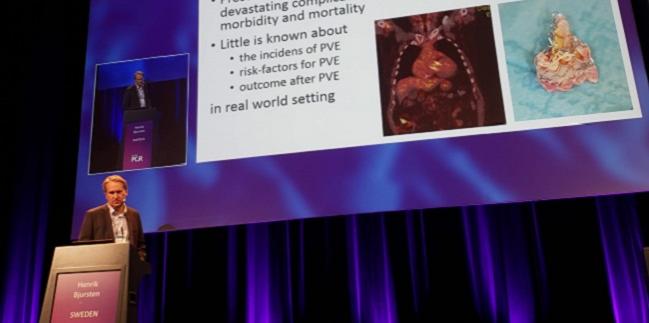Endocarditis After TAVR: Real-world Data Speak to Its Rarity but Also the ‘Devastating’ Impact
Good news: TAVR carries no more PVE risk than SAVR. Bad news: prognosis after these infections is grim, EuroPCR presenters said.

PARIS, France—A rich evidence base exists describing prosthetic valve endocarditis (PVE) that occurs after surgical aortic valve replacement (SAVR), but much less is known about its causes and consequences in transcatheter procedures, especially over the long term and in real-world use.
Two registry studies—one from Finland and the other from Sweden—presented recently at EuroPCR 2019 addressed this knowledge gap, with an eye on the future of TAVR.
“PVE has been described as being a causative factor of bioprosthetic valve dysfunction,” Noriyaki Moriyama, MD (Helsinki University Central Hospital, Finland), told attendees here in a late-breaking session. With TAVR’s expansion into lower-risk patients with longer life expectancies, he said, it’s crucial to gain better understanding about PVE’s implications for long-term durability.
In his presentation, Henrik Bjursten, MD, PhD (Lund University, Sweden), emphasized that PVE is a “devastating complication, with high morbidity and mortality [as well as] cost to the patient, cost to the society.” Getting an accurate picture of PVE’s incidence, predictors, and outcomes after TAVR is essential, he said.
Similar PVE Risk Between TAVR and SAVR
Moriyama and colleagues collected data from the nationwide, retrospective FinnValve registry on 6,463 patients who underwent aortic valve replacement (33% of it TAVR) between January 2008 and October 2017. Among them, 68 (1.05%) developed PVE involving their bioprostheses over a mean follow-up period of 3.5 years (range, 0 to 10 years).
Rates were similar between TAVR (0.70%; 3.4 cases per 1,000 person-years) and SAVR (1.22%; 2.9 cases per 1,000 person-years). On Kaplan-Meier analysis, the 8-year risk was 1.28% with TAVR and 1.39% with SAVR. Predictors of PVE were male sex (HR 1.73; 95% CI 1.04-2.89) and deep sternal wound or vascular access site infections (HR 5.45; 95% CI 2.24-13.23).
Post-PVE, the death rate was 37.7% at 1 month and 52.5% at 1 year. Cases treated by surgery were less likely to result in death (HR 0.34; 95% 0.21-0.61).
Alain Cribier, MD (Hôpital Charles Nicolle, Rouen, France), who co-moderated the session, described the data as “really fascinating.” That TAVR did as well as SAVR in terms of low PVE risk is good news, but “the bad thing is that we are not making enough effort to decrease the number of infections at the puncture site and that’s probably because we have this interventional cardiology culture and we’re not [typically] working in the OR.” The implication was that this might be a means to reduce occurrence of PVE. However, when asked about access-site infections in the data set, Moriyama replied the rate was only 7% among PVE patients.
Myriad Predictors That Shift Over Time
For their study, Bjursten et al gathered data from various Swedish registries on 4,134 TAVR patients, of whom 103 (2.6%) developed PVE.
Predictors of PVE were higher body surface area (BSA), estimated glomerular filtration rate (eGFR) < 30 mL/min/173 m2, transapical access, higher mean gradient pre-TAVR, critical preoperative state, higher contrast volume, and atrial fibrillation.
When the complication occurred within 1 year of TAVR, the strongest predictors were high BSA and low eGFR as well as aortic regurgitation grade I-III. For late PVE, BSA mattered less than in the earlier time frame; low eGFR and use of transapical access as well as infective endocarditis in the year before TAVR were all predictive. Early PVE cases were more likely than late PVE cases to involve Staphylococcus aureus and be nosocomial. Later cases were more apt to be fatal, thought the difference wasn’t statistically significant.
By 6 months, only 58% of PVE patients had survived. Patients were more likely to die if their PVE involved an abscess (OR 4.9; 95% CI 1.1-22.1) or occurred more than a year after TAVR (OR 5.6; 95% CI 1.8-17.5) but less likely to die if the infection was acquired outside of the hospital (OR 0.20; 95% CI 0.06-0.6).
Panelist Jörg Hausleiter, MD (Klinikum der Universität München, Munich, Germany), asked for more details about how PVE was treated among these patients.
In reply, Bjursten said only two of the 103 had their complication treated surgically. “As patients get younger, we will see more of these surgeries,” he predicted. Of those who took antibiotics, “there were three patients who had a second endocarditis and none had a third endocarditis, so that’s fairly good.”
Many of the risk factors for PVE relate to older age, so these will shift as the TAVR population changes, Bjursten pointed out during the discussion. Panelist Francesco Bedogni, MD (Policlinico San Donato, Milan, Italy), wondered, too, whether comparing the TAVR and SAVR numbers from the Swedish databases might add insight on predictors of PVE. “We could pool the data [but] it will be apples and oranges,” Bjursten said, noting that propensity adjustment would not be able to remove all confounders.
That said, Bjursten agreed that PVE risk appears to be on par between TAVR and SAVR.
Caitlin E. Cox is News Editor of TCTMD and Associate Director, Editorial Content at the Cardiovascular Research Foundation. She produces the…
Read Full BioSources
Moriyama N. Prosthetic valve endocarditis after transcatheter or surgical AVR with a bioprosthetic valve: results from the FinnValve registry. Presented at: EuroPCR 2019. May 21, 2019. Paris, France.
Bjursten H. Infective endocarditis after TAVI - a nationwide study. Presented at: EuroPCR 2019. May 21, 2019. Paris, France.
Disclosures
- Moriyama reports no relevant conflicts of interest.
- Bjursten reports receiving honoraria or consulting fees from Boston Scientific and Edwards Lifesciences as well as being the founder/owner of Septulus AB.


Comments